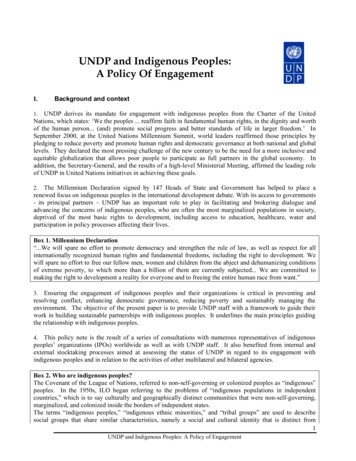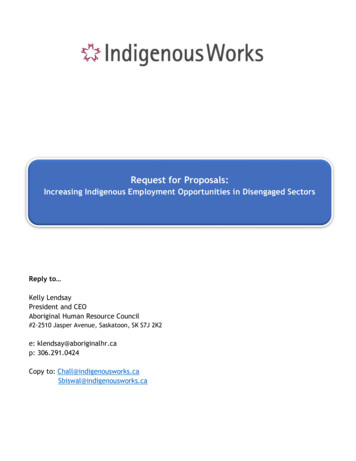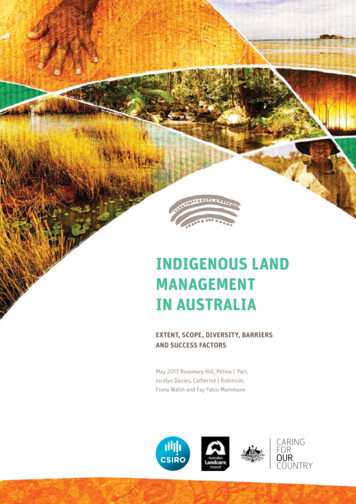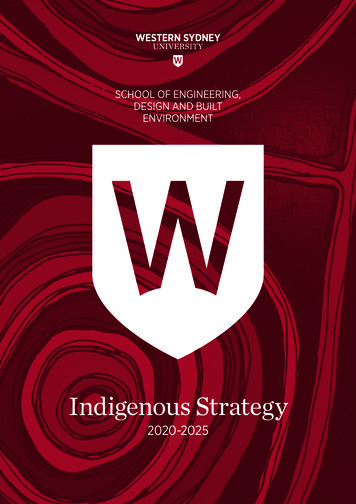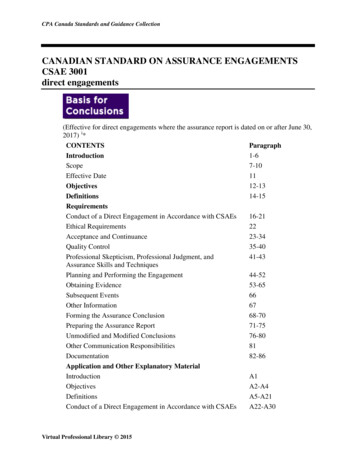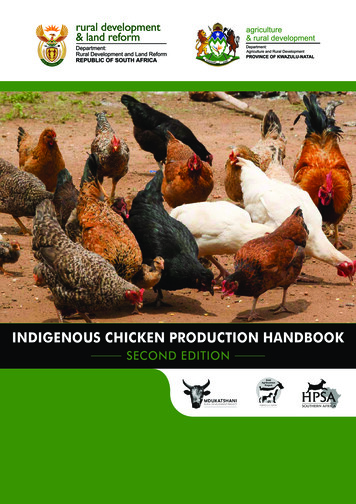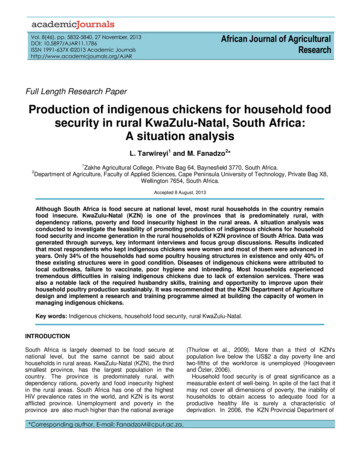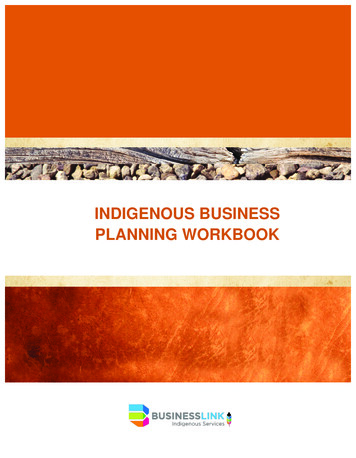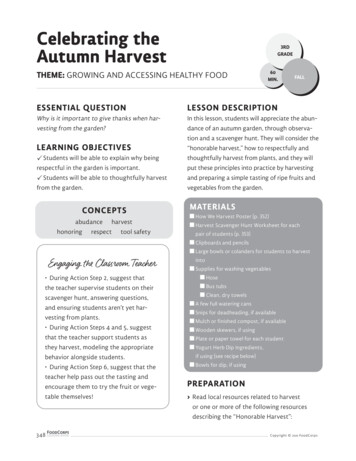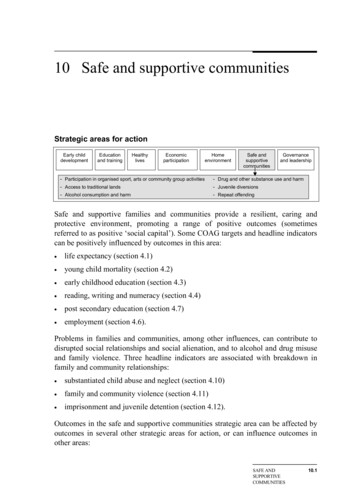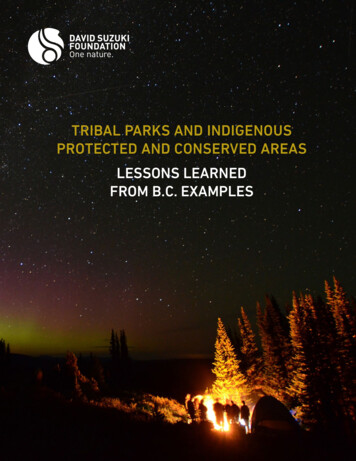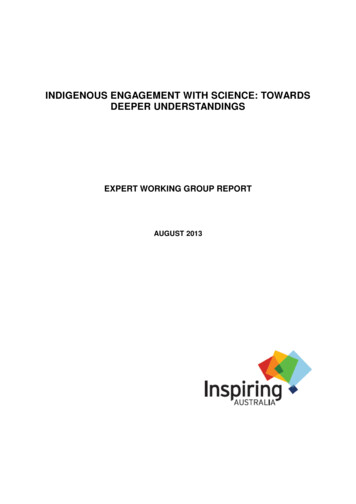
Transcription
INDIGENOUS ENGAGEMENT WITH SCIENCE: TOWARDSDEEPER UNDERSTANDINGSEXPERT WORKING GROUP REPORTAUGUST 2013
Prepared by the Expert Working Group on Indigenous Engagement with ScienceChaired by Winthrop Professor Jill Milroy, AMDean, School of Indigenous Studies, University of Western Australiaas part of Inspiring Australia.For more information about Inspiring Australia, please contact:ManagerInspiring Australia StrategyQuestacon - The National Science and Technology CentreDepartment of Innovation, Industry, Climate Change, Science, Research andTertiary EducationPO Box 5322Kingston ACT 2604Telephone: 61 2 6270 2868Email: Inspiring.Australia@innovation.gov.auYou can access this report from the Department's Internet site at:http://www.innovation.gov.au/CopyrightWith the exception of material that has been quoted from other sources and isidentified by the use of quotation marks ' ', or other material explicitly identified asbeing exempt, material presented in this report is provided under a CreativeCommons Attribution 3.0 Australia licence.The details of the relevant licence conditions are available on the Creative Commonswebsite at .en.ISBN 978-1-921916-89-2 (print)978-1-921916-88-5 (electronic)The document should be attributed as Indigenous Engagement with Science: towardsdeeper understandings.
ContentsAcknowledgments . vKey findings . viSummary of recommendations . viiiIntroduction. 1History of Indigenous engagement with science. 2Indigenous knowledge and science— complementary systems . 5Indigenous languages—storehouses of knowledge . 7Language and Indigenous ecological knowledge . 7Aboriginal languages—economic value . 8Intergenerational learning—the importance of language to Indigenousknowledge . 8Changing cultural paradigms . 9Role and composition of the Expert Working Group . 10Recommendations. 11Theme 1. Indigenous knowledge systems . 11Theme 2. A National Indigenous Science Agenda . 12Theme 3. Indigenous priorities . 14Theme 4. Communication . 15Theme 5. Engage Indigenous young people in the sciences . 17Appendix 1 Expert Working Group composition . 19Appendix 2 Education through consultation, recognition and access. 22Consultation . 23Externally controlled consultation . 24Community-initiated consultation. 24Recognition of and respect for Indigenous knowledge . 25Commitment to Indigenous knowledge . 26Training in Indigenous knowledge . 26Employment opportunities for Indigenous people . 27Building understandings with Indigenous knowledge . 28Access. 28Awareness . 29Indigenous engagement with science: towards deeper understandingsiii
Bridging . 30Support. 31Reaching out . 31Visits. 32Hosting . 32Support. 33Further reading . 34Indigenous engagement with science: towards deeper understandingsiv
AcknowledgmentsThe Expert Working Group on Indigenous Engagement with Science would like tothank the Australian Institute of Aboriginal and Torres Strait Islander Studies(AIATSIS) as convener of this project and for providing professional andadministrative support. We would also like to acknowledge the staff of the School ofIndigenous Studies at the University of Western Australia for research assistance andproduction of our scoping report, as well as the Commonwealth Scientific andIndustrial Research Organisation (CSIRO), Australian National University, CharlesDarwin University, North Australian Indigenous Land and Sea Management Alliance(NAILSMA), Peter MacCallum Cancer Centre and Madjulla Inc. for the generousavailability of their staff and members in the conduct of this project.Indigenous engagement with science: towards deeper understandingsv
Key findingsThe Expert Working Group on Indigenous Engagement with Science recognises theurgency of increasing the engagement of Aboriginal and Torres Strait Islanderpeoples in the development and communication of sciences in Australia. Animportant step in achieving this is understanding and valuing Indigenous knowledgesystems, acknowledging the significant contribution that Aboriginal and Torres StraitIslander peoples have already made to the development of science in Australia, andsharing this within the Indigenous community as well as with the scientific andbroader Australian community.In our preliminary scoping study of this area, the Expert Working Group agreed thatthe interaction between Indigenous Australians, science and the broader sciencecommunity is lacking in many areas and from all sides. Aboriginal and Torres StraitIslander peoples have unique knowledge systems that can contribute to all fields ofscientific endeavour, including science-based activities such as the management ofAustralia's natural resources. While it was evident to the Expert Working Group thatIndigenous knowledge systems have contributed significantly to research in Australiain the past and continue to do so today, it was also evident that this contribution is notalways acknowledged or valued appropriately as a 'scientific' contribution. WhileIndigenous knowledge systems contain a wealth of scientific information theirdevelopment is often poorly resourced in Indigenous communities as well as in thewider community and the transfer of traditional knowledge and skills to futuregenerations is critically threatened.The major issue of maintaining Indigenous knowledge systems is not simply an issueof science engagement—it is an issue of national significance for all Australians. ThisExpert Working Group would like to emphasise the need for large, ongoing andsystemic change to ensure the ongoing health of Indigenous knowledge systems.While there was a degree of consultation and opportunity for public comment duringthe process of developing this report, it was strongly agreed by the members of theExpert Working Group that the interests of remote Indigenous communities would notbe met by attempting a full and broad consultation within the time and resourcesavailable to the Group. Rather, it will be essential to undertake future, dedicated workto ensure that traditional knowledge holders and language speakers are able toparticipate in a meaningful way in augmenting and implementing therecommendations of this report.Urgent action is therefore required across a range of initiative areas. The ExpertWorking Group considers these areas also present significant opportunities forgovernment and industry to engage with Indigenous people in a way that willmaximise the potential for increased productivity across a wide range of scientificactivity. The most challenging recommendations refer to the urgent need to conserveand prevent further loss of Indigenous knowledge. Critical enabling actions willrequire urgent application of resources to: protecting Indigenous languages;recognition of knowledge holders by tertiary education institutions and industries;facilitating knowledge and skill sharing between researchers and communities; andIndigenous engagement with science: towards deeper understandingsvi
providing opportunities for Indigenous knowledge to generate economic benefit forIndigenous communities while protecting Indigenous cultural interests.The Expert Working Group has made 12 recommendations to strengthen Indigenousengagement in science. To be successful, the changes and actions recommendedwill need to be owned by both Indigenous communities and the broader scientificcommunities.Indigenous engagement with science: towards deeper understandingsvii
Summary of recommendationsNo.Recommendation1Resource and support the maintenance and enhancement of Indigenous knowledgesystems and intergenerational transfer of Indigenous knowledge.This should be done in a way that protects the relationships between Indigenouspeople and their knowledge and skills by ensuring that engagement with Indigenous'scientific' knowledge occurs on mutually agreed terms and through adherence toappropriate protocols.2Recognise and increase support for Indigenous languages as integral to the healthof Indigenous knowledge systems. Ensure the use of Indigenous languages inscience engagement.3Develop an Indigenous Australian Science Agenda that is guided by Aboriginal andTorres Strait Islander peoples. The agenda should ensure synergy with cultural,economic, social and environmental outcomes for communities.Establish and maintain an Indigenous Science Committee to oversee thedevelopment and implementation of the agenda.4Develop cultural competency tools and programs that enable scientific communitiesto: understand how Indigenous knowledge systems deepen the value andrelevance of science in Australia; and engage in full and equitable partnerships with Indigenous communities inscientific research and engagement.Resourcing Funds for seed grants to assist the implementation of the strategy. Funds to develop tools to improve the cultural competencies of scientists.5Enable Indigenous communities to develop local and regional priorities for scienceengagement, research and communication.6Provide Indigenous communities with the scientific resources to build communitycapacity to deliver on local community priorities.7That, in developing their science engagement and research agendas, government,researchers and their organisations ensure:8 local and regional Indigenous priorities are integrated into the development oftheir projects the meaningful participation and empowerment of local Indigenous knowledgeholders in project design, delivery and evaluation project outcomes deliver clear and sustainable benefits to the livelihoods oflocal communities.That governments, researchers, communicators and their organisations haveresearch 'impact measures' that include priorities and outcomes for local Indigenouscommunities.Indigenous engagement with science: towards deeper understandingsviii
No.Recommendation9Develop an Indigenous media and communication strategy to engage Indigenouspeople in science, to inform the wider community about Indigenous scienceachievement, and to create a new appreciation of the value of Indigenousknowledge systems amongst the Indigenous and broader scientific communities.Resourcing10 One full-time person to develop and implement the strategy. Funds for communication activities.Develop and sponsor science awards to recognise and profile Indigenousachievements in science. This should include: awards for young Indigenous scientists, Indigenous knowledge holders andcommunities Indigenous categories within Australia's prestigious national and state scienceawards science as a category within the Deadly Awards and other relevant Indigenousawards.11Develop educational and outreach programs that engage Indigenous young peoplein science, leading to professional careers in science and science-related areas.12Map and monitor Indigenous student enrolments and graduates in science andscience-related areas to establish a clear picture of achievements and any 'gaps'.Develop promotional material and information for Indigenous science students andgraduates to inspire, motivate and support Indigenous young people to undertakescience-related careers.Indigenous engagement with science: towards deeper understandingsix
IntroductionInspiring Australia is a national strategy led by the Federal Department of Innovation,Industry, Climate Change, Science, Research and Tertiary Education (DIICCSRTE)with the broad aim of realising the full social, economic and environmental benefits ofinvestment in science and research. Expert working groups have been formed toinvestigate particular priorities and make recommendations proposing various waysforward. One such priority is to target Indigenous Australians in urban, regional andremote locations with measures to develop their potential and interest in science andscience-based careers and thereby increase the capacity of the scientific workforce.Aboriginal and Torres Strait Islander peoples have a unique contribution to make toAustralian society. They have distinct and diverse communities and cultures, and asuccessful science engagement strategy must recognise and respond to this.According to Australian Bureau of Statistics (ABS) data from 2006, the estimatedresident Indigenous population of Australia was 517 043, or 2.5% of the totalAustralian population, with approximately 24% living in remote or very remote areas,compared to about 2% for the non-Indigenous population. The Indigenous populationhas a different age distribution profile, with 38% of the total Indigenous populationaged 15 years or younger compared to 19% of non-Indigenous Australians. At theother end of the age spectrum, only 3% of Indigenous Australians are aged 65 yearsor older compared to 13% of the non-Indigenous population (ABS 2006). This resultsin a population pyramid for Indigenous Australia more typical of a Third Worldpopulation than one resident in a developed nation.Indigenous people are less likely to be employed in Professional, Scientific andTechnical Services than non-Indigenous people (approximately 2% compared to 7%).Roughly the same proportion of Indigenous and non-Indigenous Australians areemployed in the Agriculture, Forestry and Fishing Industries (around 4%) (ABS2006). The Australian Indigenous Doctors Association (AIDA) noted in 2006 thatIndigenous people made up just 0.19% of medical practitioners (AIDA 2010). There isa clear need for action to graduate and employ more Indigenous Australians asscientists, engineers and doctors to reach rates of employment comparable withthose of non-Indigenous people and increase the capacity of the Australian scientificworkforce overall.In order to increase the number of Indigenous Australians participating in science,education needs to provide a solid grounding in scientific literacy. Data from theOECD Program for International Student Assessment (PISA) shows that in 2009Indigenous 15-year-old students were still underperforming compared to nonIndigenous students, with only 37.8% of Indigenous students, compared to 68.5% ofnon-Indigenous students, reaching the accepted level of proficiency in scienceliteracy. The improvement in this metric since the 2006 PISA results is not statisticallysignificant (Commonwealth of Australia 2011a). A secondary analysis of the 2006results showed that the underperformance could largely be explained by thevariability in reading literacy and that Indigenous students were shown to be just asinterested (actually slightly more interested) in science as their non-Indigenous peers(McConney et al. 2011).Indigenous engagement with science: towards deeper understandings1
History of Indigenous engagement with scienceThe earliest history of Aboriginal and Torres Strait Islander peoples' engagement withWestern science was one in which they were the subjects of morbid curiosity andwere examined as one would examine the flora and fauna of the country. In somecases the flora and fauna were treated with greater admiration and respect thanIndigenous people. The advent of Social Darwinism acted to reinforce racialhierarchies rather than improve the recognition of intrinsic human rights, andIndigenous knowledge was (and in some instances still is) dismissed out of hand asoffering no genuine contribution to science.For most of the last two centuries, Indigenous people continued to be excluded fromhaving any status as partners or participants in scientific investigation. Prevailingcolonial attitudes, reinforced by a wide range of government policies, resulted inminimal recognition and often the devaluing of Indigenous knowledge systems.Limited access to school education and almost total exclusion from participation inhigher education ensured that the cultural, social, political and economicdevelopment of Aboriginal communities was at the mercy of a disinterested, oftenantagonistic, White Australia. For many Aboriginal and Torres Strait Islander people,this exclusion is understood as stemming from being placed in low position on theDarwinist ladder and the privileging of Western science as the 'teller of truth' (Rigney2001).Since the late 20th century, as Western science has become increasingly focused onenvironmental sustainability, climate change and global warming, there has been asignificant shift towards seeking solutions within Indigenous knowledge systems inorder to mitigate the impact of globalised industrialisation. Central to this is anincreasing awareness of the intrinsic resilience of Indigenous communities. At thesame time, Western science has also sought the knowledge of Indigenous peoples togain insights into the properties of plants (e.g. Kakadu plum) as a source of productsfor medical and food research. This research collaboration has yet to significantlycontribute to the livelihood of Indigenous communities and, while they may no longerbe considered simply as subjects of analysis, Indigenous peoples' standing hasprogressed little beyond roles as informants or field assistants to researchers. TheIndigenous contribution to science has become welcomed but not well recognised orrewarded.Aboriginal and Torres Strait Islander peoples' unique access to land and searesources as traditional owners should provide an economic base on which to buildenterprise and employment. Business ventures in Australia (and across the world)that are land- or sea-based, including pastoralism, forestry, ecotourism, fishing andaquaculture, are increasingly threatened by fire, drought, flood, climate change anddepletion of fish stocks. The current difficulties for Aboriginal and Torres StraitIslander people in having their diverse knowledge recognised, and in accessing andparticipating in scientific research, effectively limit the capacity of Australia'sIndigenous cultures to contribute solutions to these challenges. At the same time,opportunities for Indigenous communities to develop sustainable livelihoods are alsoIndigenous engagement with science: towards deeper understandings2
curtailed, thereby maintaining or exacerbating the gap in social and economicoutcomes between Indigenous and other Australians.In recent years there has been increasing recognition of the critical contribution thatIndigenous knowledge makes to biodiversity conservation, ecological processes andsustainable resource use and management. Indeed, the rapid, grassroots-drivengrowth of an Indigenous community ranger workforce in recent decades, especially inCentral and Northern Australia, is one of the strongest areas of Indigenousengagement in science (Kennett et al. 2011; Luckert et al. 2007). However, researchin these domains has been dominated by researchers operating within a Westernscience framework and with outcomes that are usually defined and driven bygovernment policies, programs and funding guidelines (Lane et al. 2009), and byresearchers themselves, rather than by Indigenous community interest. The politicssurrounding the evaluation of projects in natural resource management has beenfound to be especially problematic when the parties seek differing outcomes andbenefits (Robinson et al. 2009). In research contracts and agreements, governmentor commercial/corporate parties maintain a dominant influence which does notalways give proper consideration to the provision of mutual benefits for Indigenousparties. There have been recent positive developments, such as fire researchprograms that are helping to create longer term livelihood opportunities based on thecarbon pollution reduction benefits of Indigenous traditional burning practices(Barnsley & NAILSMA 2009); however, in the majority of cases the benefits that doaccrue to Aboriginal and Torres Strait Islander peoples from ecological research havebeen short term—often only for the duration of the particular research—and/ordependent on future government funding on a year-to-year basis. To date, within theplethora of scientific research projects, there are few if any that can be credited withachieving sustainable outcomes for Indigenous Australians or where substantialbenefits have accrued to Indigenous people.In the rapid movement toward a knowledge-based economy in Australia and globally,it is imperative that Indigenous knowledge systems are appropriately acknowledgedfor the contributions that they currently make, and appreciated for their capacity tocontribute even more. The acceptance of the term 'traditional knowledge', rather thanIndigenous knowledge, within intellectual property law has limited and constrainedthe recognition of the rights of Indigenous peoples as owners of comprehensive andevolving knowledge systems and thereby has limited their rights as beneficiaries(Janke & Frankell 1998). In this way, Indigenous rights have been and continue to beconstrained by government and Australian legal definitions, rather than beingrecognised as pre-existing and intrinsic rights and values within Indigenous law andpractice. Although international covenants have been established on the protection ofthe rights of Indigenous peoples globally (e.g. the UN Convention on BiologicalDiversity (CBD), relating to genetic resources and Indigenous knowledge, and the UNDeclaration on the Rights of Indigenous Peoples (UNDRIP)), there is still a failurewithin intellectual property law to give Indigenous knowledge its full due.The UNDRIP and the CBD provide building blocks to legitimise the inclusion ofIndigenous rights within scientific research. However, the continuing limitedparticipation of Aboriginal and Torres Strait Islander peoples undertaking science inhigher education institutions precludes Indigenous Australians from taking advantageIndigenous engagement with science: towards deeper understandings3
of the opportunities that may be afforded. Studies have shown that Western sciencedoes not allow for a range of differing cultural aspects to be expressed and valued,and where education is not culturally responsive it becomes irrelevant to those itendeavours to inform (Fleer 1997 in McKinley Jones Brayboy & Castagno 2008;McLisky & Day 2004). The specialised words and phrases used in school scienceeducation serve to hamper Indigenous engagement and participation. This too oftenresults in limited interest or participation beyond secondary school, where studentshave a choice in the studies they undertake.At the tertiary level, it has been found that the lack of Indigenous studentsundertaking science is based on the belief among the students that there would be'no mentors, no role models, no future prospects for careers and no perceivedpositive outcomes for them or their communities' (McLisky & Day 2004). Researchundertaken over the years by CSIRO, various cooperative research centres andgovernment departments has not produced long-term employment at the level ofscientific researchers. Often any Indigenous employment that has occurred has beenshort-term, limited by ephemeral grant funding. Such employment is often limited toshort periods of 1-3 years or to the life of the particular project, and therefore doesnot encourage Indigenous people to look to science research as a long-term career.Within Australia's current research system, no synergies have eventuated thatproduce overall or sustained benefit or education and employment outcomes forAboriginal and Torres Strait Islander peoples.Indigenous engagement with science: towards deeper understandings4
Indigenous knowledge and science— complementarysystemsGlobally, there has been increasing interest in and recognition of the value ofIndigenous peoples' knowledge, which is referred to by various terms andacronyms—including Indigenous knowledge (IK), Indigenous environmentalknowledge (IEK), traditional knowledge (TK), traditional ecological or traditionalenvironmental knowledge (TEK)—with a range of accompanying but broadlyoverlapping definitions. More recently there has been a strong emphasis, particularlyby Indigenous peoples, on promoting a broader understanding of Indigenousknowledge as a product of Indigenous knowledge systems (IKS).Indigenous knowledge systems held by Aboriginal and Torres Strait Islander peoplesare a unique and vital part of Australia's knowledge capital, and link to otherIndigenous knowledge systems worldwide. Within Australia 'Indigenous knowledge'and 'Indigenous knowledge systems' are widely used within the higher educationsector, evidenced by the number of university centres and schools with 'Indigenousknowledge' in their titles—for example, the School of Australian IndigenousKnowledge Systems at Charles Darwin University. The (Bradley) Review ofAustralian Higher Education in 2008 included in its findings that 'Indigenousknowledge should be embedded into the curriculum to ensure that all students havean understanding of Indigenous culture.' The report also concludes, in Section 3.2,that 'Indigenous involvement in higher education is not only about studentparticipation and the employment of Indigenous staff. It is also about what is valuedas knowledge in the academy' and that 'as the academy has contact with andaddresses the forms of Indigenous knowledge, underlying assumptions in somediscipline areas may themselves be challenged.' The report of the Cutler review,Venturous Australia, in the same year also acknowledged '.the unique value ofindigenous traditional knowledge and practices within Australia's innovation system'(Recommendation 7.13).The economic benefits of effective engagement with Indigenous knowledge systemsin Australia are significantly under-recognised. These benefits have the potential tonot only improve national productivity but also provide enhanced local and regionaleconomic opportunity for Aboriginal communities if they are matched withopportunities for appropriate skills development and partnership with industry.'Indigenous knowledge' and 'Indigenous knowledge systems' currently do not exist asrecognised disciplinary areas in any of Australia's tertiary education institutions andshould not be confused or conflated with 'Indigenous Studies', which historically hasmore often been about rather than by Indigenous people and is primarily locatedwithin a Western knowledge disciplinary framework. Australia's Indigenousknowledge systems are by their very nature complex holistic and interdisciplinarysystems that cannot be viewed merely as potential subsets of Australia's Westernknowledge system. The cognitive mining of Indigenous knowledge systems for the'useful bits' can often miss the broader understandings and complex relationshipsthat underpin them, leading to research outcomes that provide a quick fix rather thansustainable solutions. While there can be tension between Indigenous knowledgeIndigenous engagement with science: towards deeper understandings5
systems and Western science, increasingly there are examples of projects thatcombine the two as complementary, rather than competing, systems to producehighly successful and innovative outcomes. A good example of this from health hasbeen the employment of Ngangkaris (traditional Aboriginal healers) by theNgaanyatjarra, Pitjantjatjara and Yankunytjatjara (NPY) Women's Council in CentralAustralia. The achievement of the Ngangkaris in connecting traditional practices withmodern medicine was recognised when they were awarded the InternationalSigmund Freud Award in 2011.Indigenous engagem
thank the Australian Institute of Aboriginal and Torres Strait Islander Studies (AIATSIS) as convener of this project and for providing professional and administrative support. We would also like to acknowledge the staff of the School of Indigenous Studies at the University of Western Australia for research assistance and
